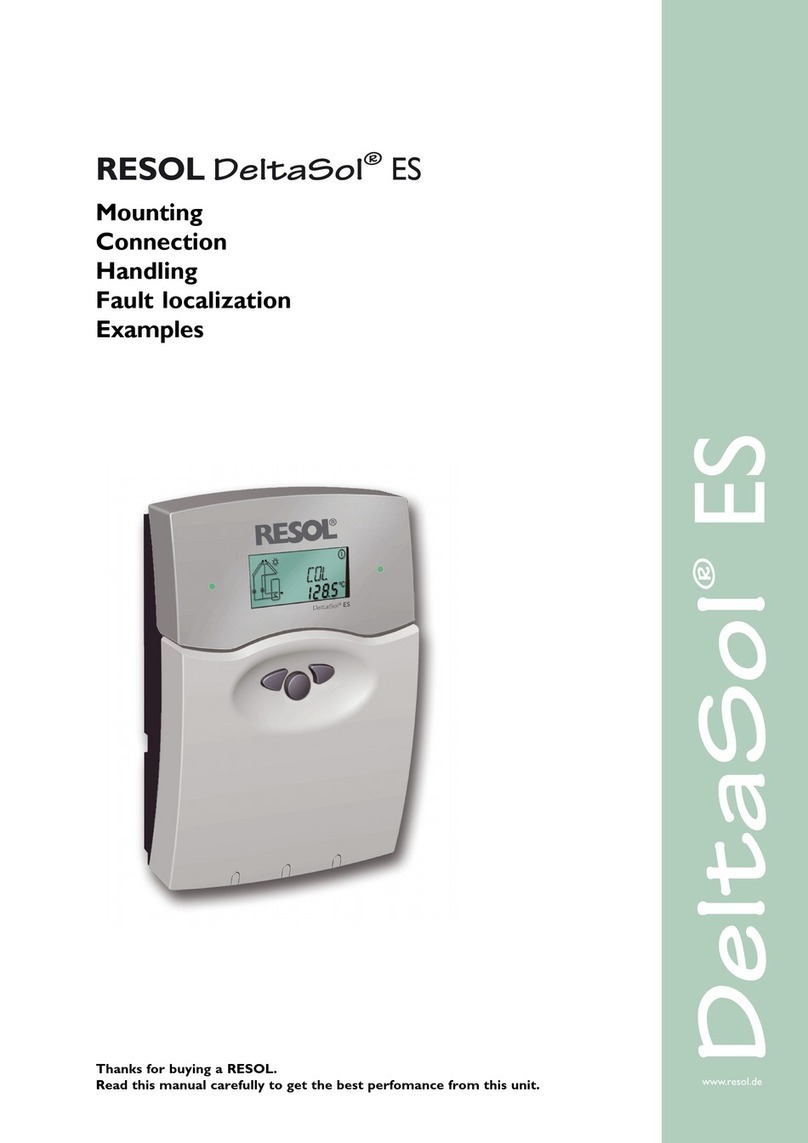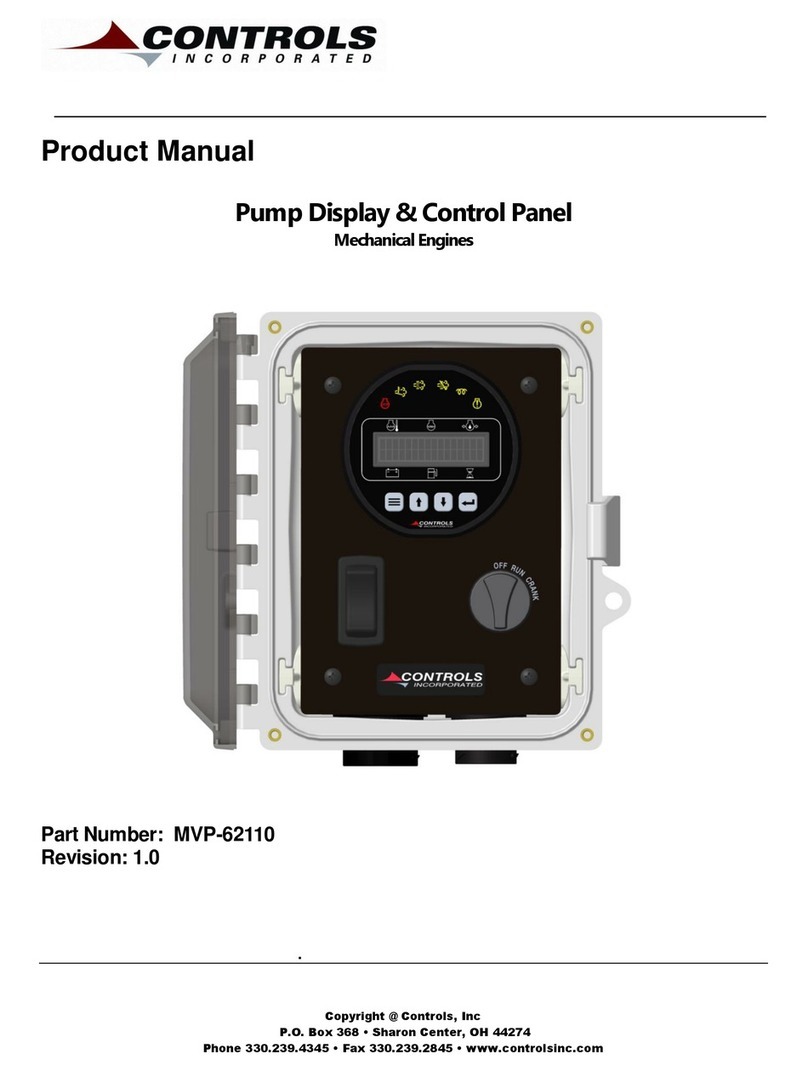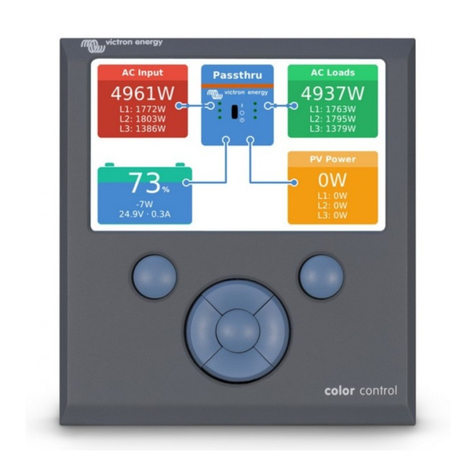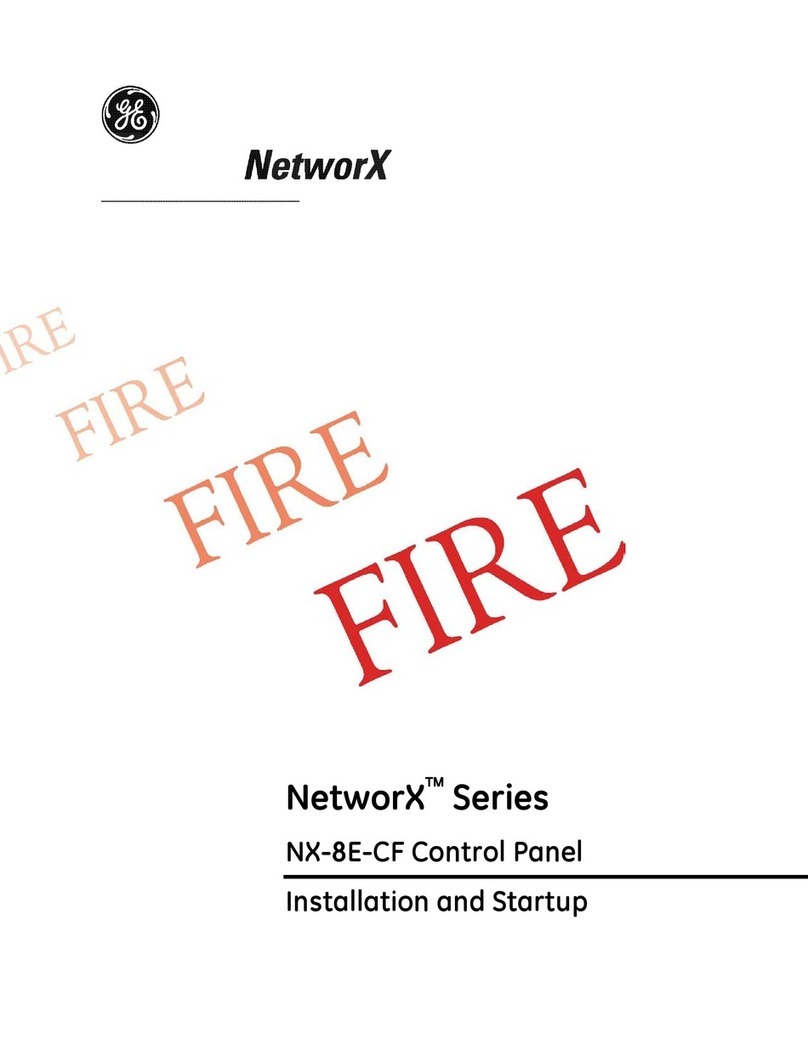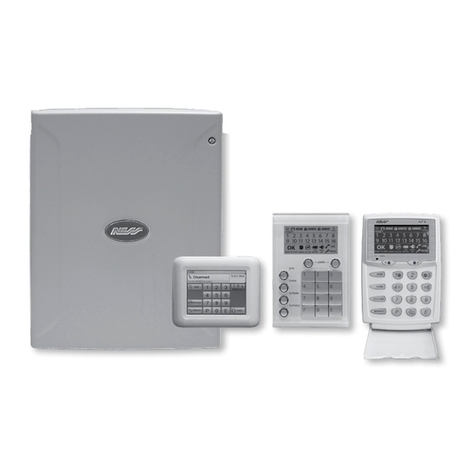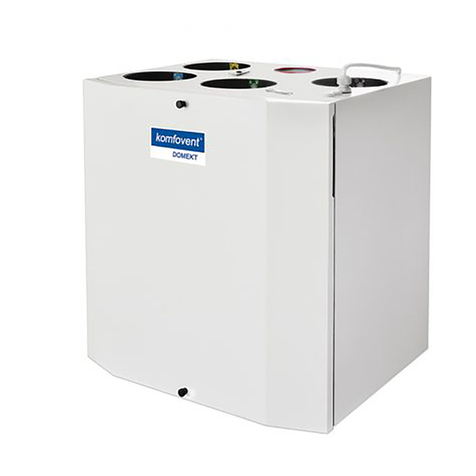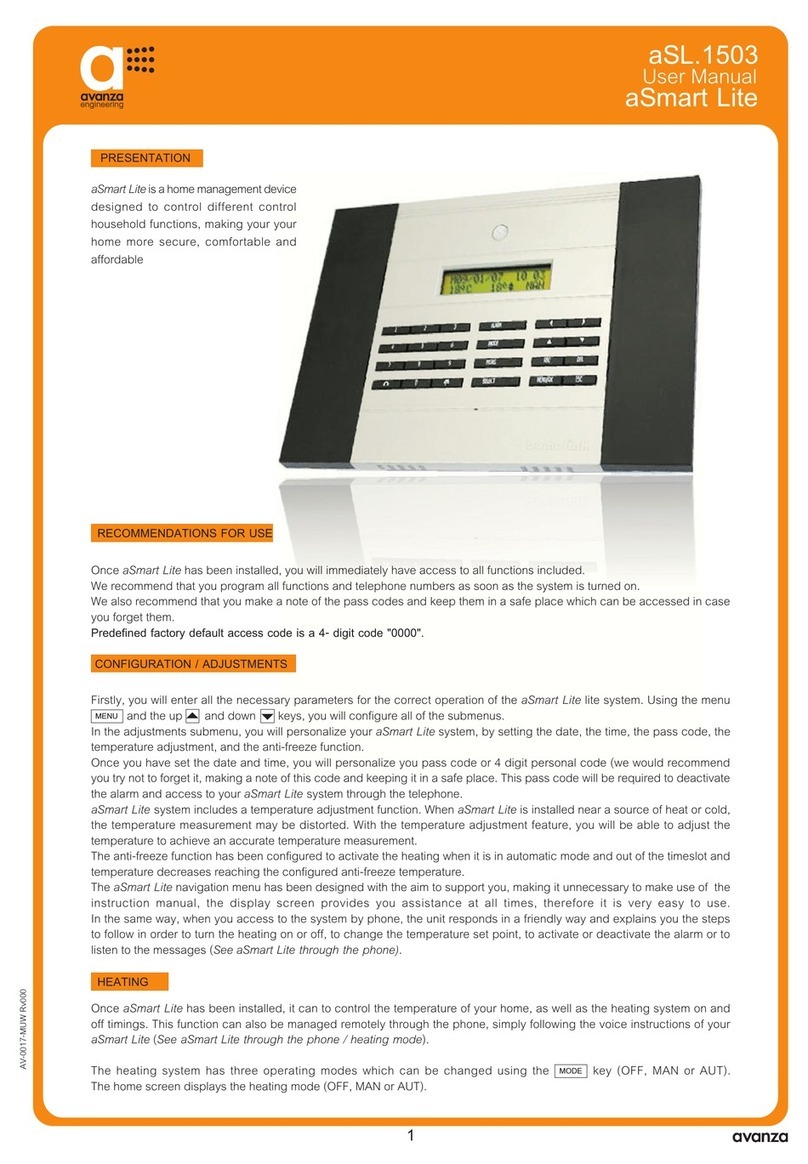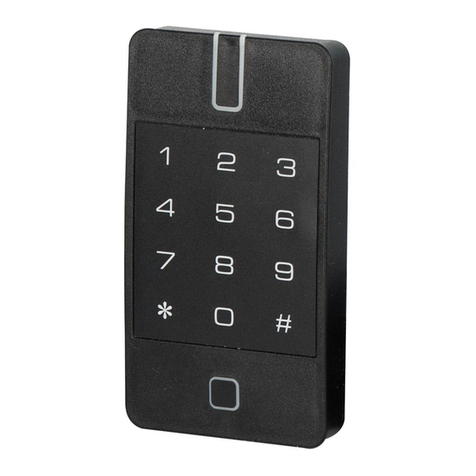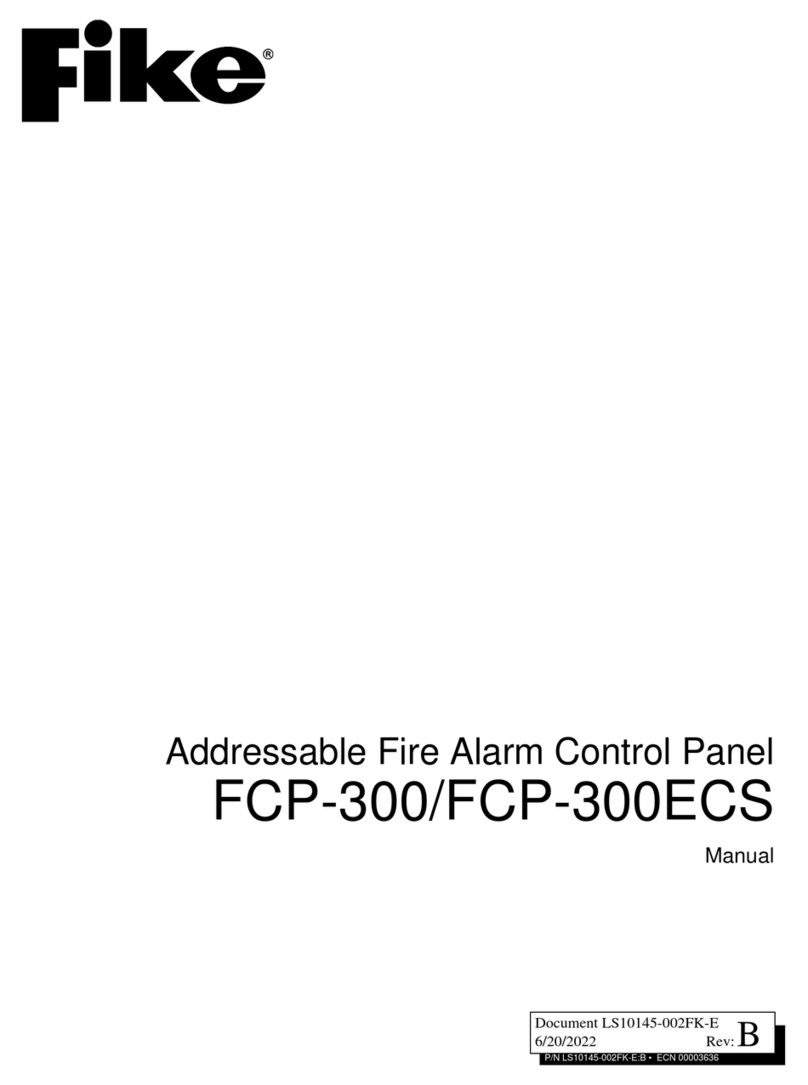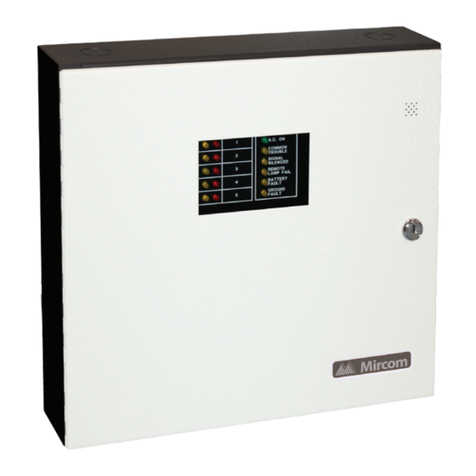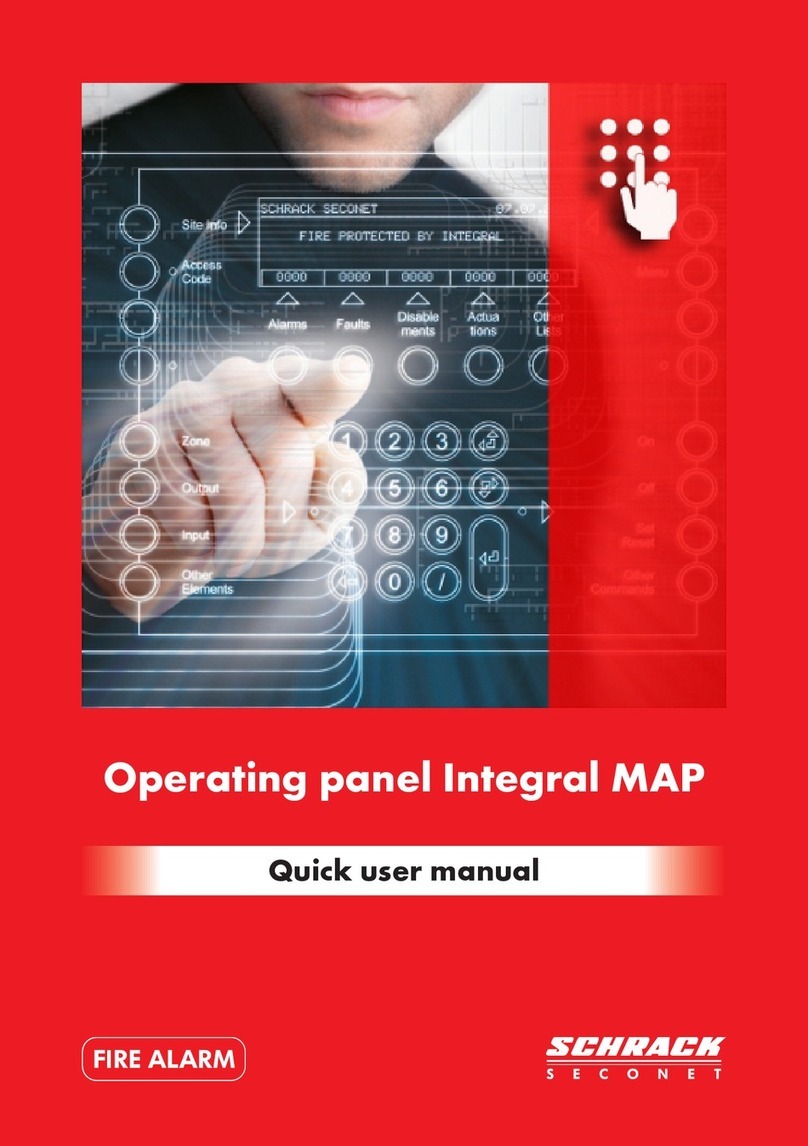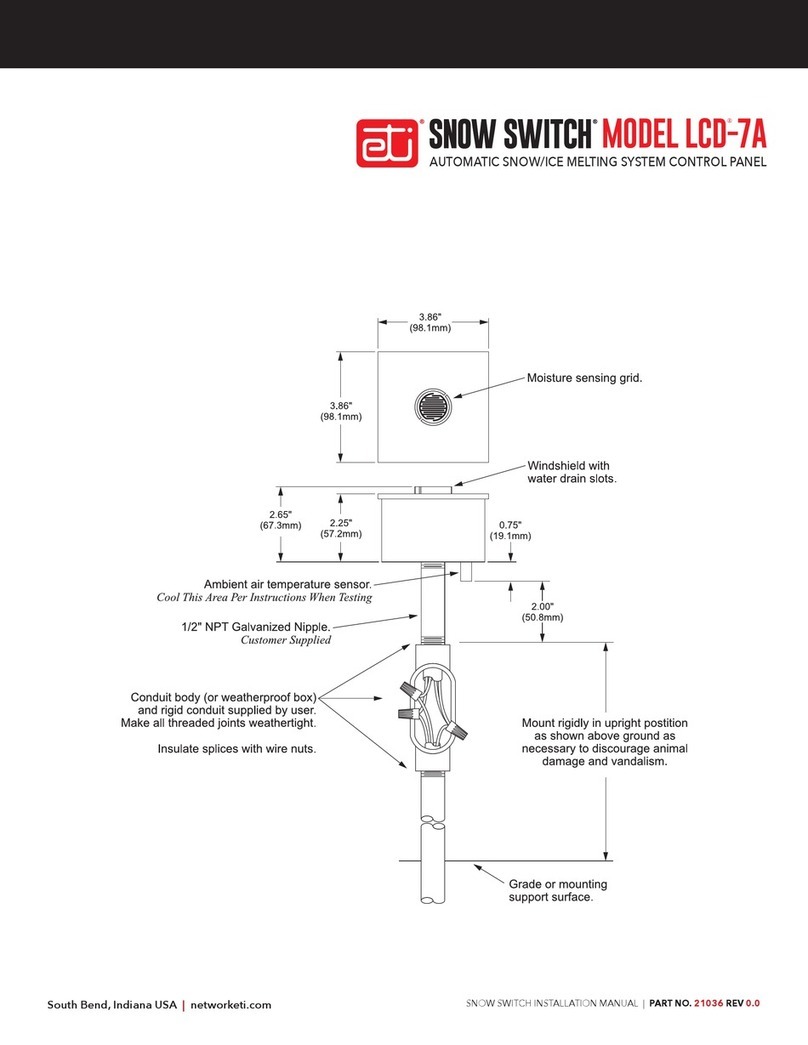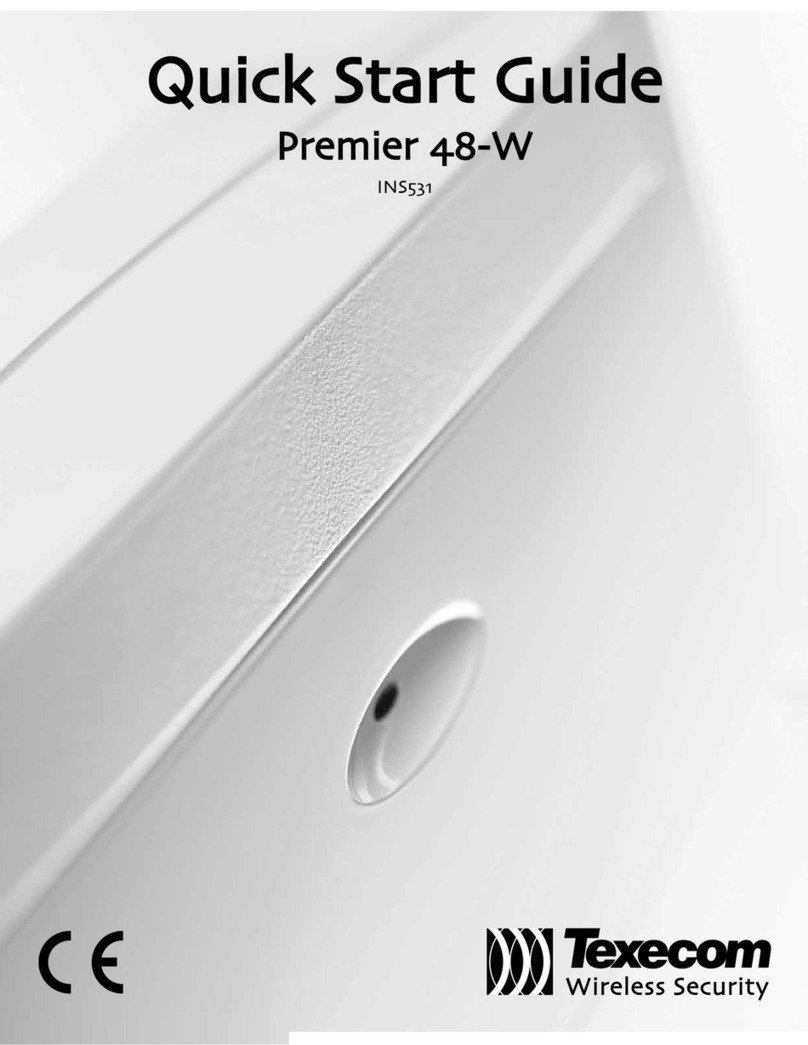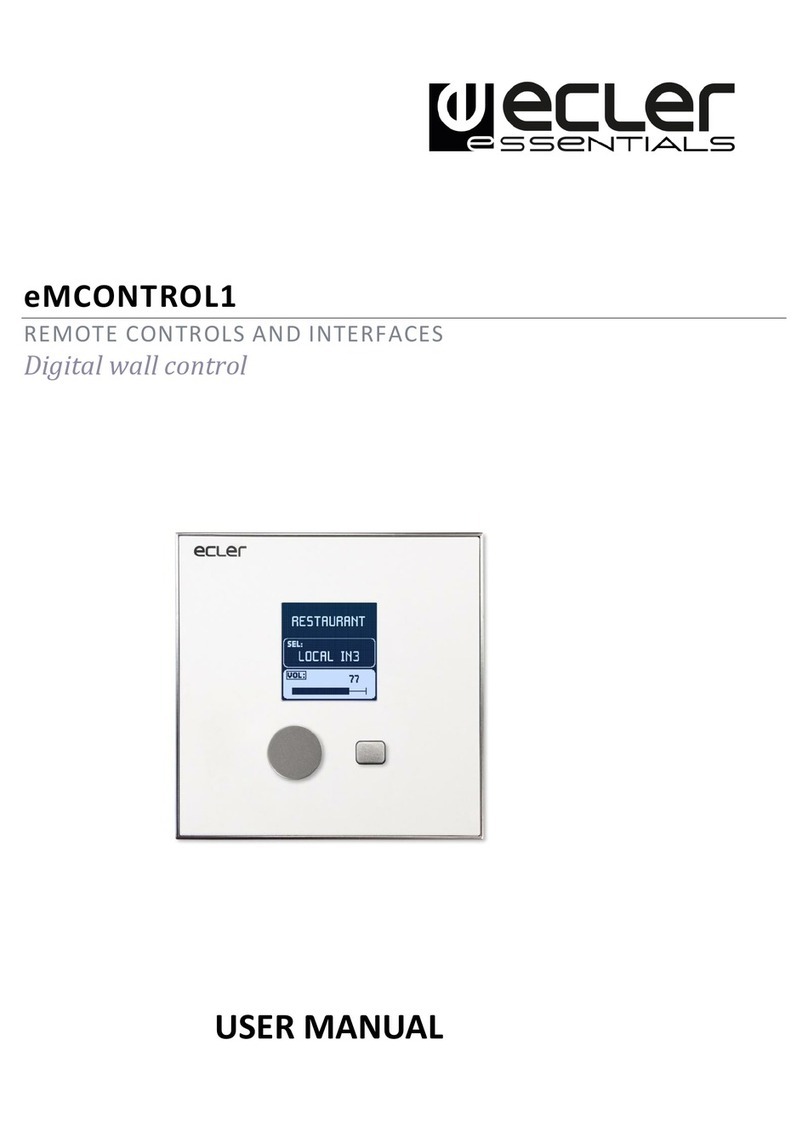NovaTec MCS-600 Series User manual

Phone 410-789-4811 Parts Email: parts@novatec.com
Main Fax: 410-789-4638 Sales: sales@novatec.com
222 E. Thomas Ave. Baltimore, MD 21225 USA
© 2018 NOVATEC, Inc. All Rights Reserved
MCS-649 & -696 IM 9 FEB 2018
MCS-648 & -696 SERIES
Conveying Control

MCS-648 & -696 IM 9 FEB 2018 Page 2 of 40
TABLE OF CONTENTS
SECTION PAGE
1PURPOSE OF THIS MANUAL ............................................................................................................4
1.1 Explanation of Symbols....................................................................................................................4
2SAFETY PRECAUTIONS AND WARNINGS......................................................................................5
3GENERAL DESCRIPTION .................................................................................................................. 6
4SPECIFICATIONS ...............................................................................................................................7
5PLC OVERVIEW.................................................................................................................................. 8
5.1 General.............................................................................................................................................8
5.2 Startup And Power Loss ..................................................................................................................8
6OPERATING PRINCIPLES ................................................................................................................. 9
6.1 Material Conveying System (MCS)..................................................................................................9
6.2 Vacuum Power Unit (VPU)...............................................................................................................9
6.3 Molding Machine (MMS)..................................................................................................................9
6.4 VPU FIFO Queue...........................................................................................................................10
6.5 Alarms............................................................................................................................................10
7ADDING NODES (DEVICENET PLUG & PLAY)..............................................................................11
7.1 DeviceNet Remote I/O...................................................................................................................11
7.2 DeviceNet I/O Data Map................................................................................................................11
7.3 Status Lights ..................................................................................................................................11
7.4 Network Switches...........................................................................................................................11
7.5 Connector Pin-Outs........................................................................................................................12
7.6 Typical Field Wiring........................................................................................................................12
8NODE ADDRESSES..........................................................................................................................14
8.1 Loading Station Nodes...................................................................................................................14
8.2 VPU Nodes ....................................................................................................................................14
8.3 Unused Nodes ...............................................................................................................................14
9INSTALLATION .................................................................................................................................15
9.1 Mechanical Installation...................................................................................................................16
9.1.1 Material Conveying Lines......................................................................................................16
9.1.2 Vacuum Power Unit...............................................................................................................16
9.1.3 Cyclone Filter.........................................................................................................................17
9.1.4 Station Valves........................................................................................................................17
9.1.5 Single Inlet Vacuum Chamber...............................................................................................17
9.1.6 Compressed-Air Blowback....................................................................................................17
9.1.7 Purge Valves.........................................................................................................................17
9.2 Electrical Installation ......................................................................................................................18
10 CONTROLS EXPLANATION ............................................................................................................19
10.1 PanelView Plus 1000.....................................................................................................................19
10.2 Startup............................................................................................................................................19
11 OPERATOR SCREENS..................................................................................................................... 20
11.1 Main Menu .....................................................................................................................................20
11.2 Vacuum Pumps..............................................................................................................................22

MCS-648 & -696 IM 9 FEB 2018 Page 3 of 40
11.3 MCS Station Status........................................................................................................................25
11.4 Station Setup..................................................................................................................................27
11.5 Alarm Banner .................................................................................................................................30
11.6 Alarm History..................................................................................................................................31
11.7 System Setup Screen ....................................................................................................................32
11.8 Install Stations................................................................................................................................35
12 MAINTENANCE................................................................................................................................. 36
12.1 At Startup .......................................................................................................................................36
12.2 Monthly...........................................................................................................................................36
12.3 Every 3 Months ..............................................................................................................................36
13 TROUBLESHOOTING....................................................................................................................... 38
13.1 DeviceNet Network ........................................................................................................................38
WARRANTY ...............................................................................................................................................39
WARRANTY PERIODS:............................................................................................................................. 39
LIST OF TABLES PAGE
Table 8-1: Node Addresses .......................................................................................................................14
Table 11-1: Alarm Messages.....................................................................................................................30
Table 13-1: Indicator Lights.........................................................................................................................38

MCS-648 & -696 IM 9 FEB 2018 Page 4 of 40
1 PURPOSE OF THIS MANUAL
This manual describes the installation and operation of Novatec’s MCS-600 Series Material Conveying
System controller. Before installing this product, please read in their entirety, this guide and any
additional guides associated with the system’s auxiliary equipment.
1.1 Explanation of Symbols
This manual includes both general and task-specific safety precautions. These precautions are
highlighted in the manual by the following categories:
WARNING: This symbol identifies situations thatare potentially hazardous to
personnel or equipment.
NOTE Highlights information provided in text or procedures. This information may
or may not be related to safety.

MCS-648 & -696 IM 9 FEB 2018 Page 5 of 40
2 SAFETY PRECAUTIONS AND WARNINGS
These operating instructions must be read, understood, and implemented by all personnel responsible for
this system.
All mechanical and electrical work must be performed by qualified personnel only.
Always disconnect power before servicing.
Refer to the machine nameplate and drawings supplied with this system for actual power requirements.
Be sure to install the equipment in the proper electrical area according to the NEMA rating
specified. Care must be taken to adhere to all national and local regulations.
Electric power supply should be through a separate disconnect switch with properly sized
overload/fuse protection.
Thread protectors and caps provided on solenoid valves, traps, pipe ends, etc. must be removed
prior to start-up.
The customer is required to operate the equipment with all safety features in proper working
condition.
Novatec shall provide no further guarantee for function and safety in the event of unauthorized
modifications.

MCS-648 & -696 IM 9 FEB 2018 Page 6 of 40
3 GENERAL DESCRIPTION
The Novatec MCS-600 Series controller is a custom-programmed Allen-Bradley PLC-based control
system designed to incorporate existing and future equipment. The Material Conveying System (MCS)
will control up to120 JIT chambers and 20 Vacuum Pump Units (VPU).
Future loading stations are made available to operations on a password protected screen. Assignments
for current and future VPUs and Stations may be changed via a password-protected screen on the HMI.
Figure 1: MCS-600 Series Enclosure and Back-Panel.
Optional Ethernet
Module

MCS-648 & -696 IM 9 FEB 2018 Page 7 of 40
4 SPECIFICATIONS
Description
Material Conveying System Controller
Model No
MCS-648
MCS-696
Performance Specifications
Max No. of Dryers
4
8
Max No. of Vacuum Power Units
8
16
Max No. of Vacuum Receivers
48
96
Main PLC
Allen-Bradley CompactLogix L32E
Base Operator Interface
Allen-Bradley PanelView Plus 1000
Remote Operator Interface
N/A
Communications
DeviceNet, Ethernet
Output Voltage to Devices
24 VDC
Input Voltage from Devices
24 VDC
Dimensions (H x W x D) Inches
Main Base Unit
24 x 20 x 8
Remote I/O Base Unit
N/A
Power Requirements
Electrical Classification
NEMA 4 / 12
Base Unit
115 / 1 PH / 60HZ
DeviceNet I/O Power Supply
90 - 264 VAC, 50 - 60 HZ or 110 - 375 VDC, 2-4 Amps
Program Information
Operator Interface
-
PLC
-

MCS-648 & -696 IM 9 FEB 2018 Page 8 of 40
5 PLC OVERVIEW
5.1 General
The MCS-600 Series Material Conveying System Controller utilizes a centrally mounted PLC that
sends commands over the DeviceNet network to various conveying system components. A
remote I/O block controls each pump, station, loader, etc. The physical device and its associated
electronics form a ‘node’. Refer to the specifications page for the maximum number of Loading
Station and Vacuum Pump nodes supported by this system.
This type of control system requires much less wiring in order to install and maintain the material
conveying system.
The MCS’s programming allows for additional equipment to be installed at a later date without re-
programming.
5.2 Startup And Power Loss
When power is first applied to the PLC following a power loss, the system will automatically start loading
enabled stations that have material demand if the AUTO START ON POWER UP mode has been
selected. If a Loading Station or Vacuum Pump is enabled, as indicated by ON, it will remain enabled.
This prevents the operator from having to restart each piece of equipment. When first starting up, each
station will have to be configured with the proper vacuum pump assignment, load, fill and dump times, no
load alarm cycles, material number, and be enabled.
In the System Setup page is the button defining the power up mode:
This button allows the user to select the start-up mode for the
control panel: AUTO or MANUAL power up. In AUTO START ON
POWER UP, the control panel will automatically start filling
stations if they are enabled and demand material when power is applied to the panel. In MANUAL
START ON POWER UP, the system is paused and the user must press the SYSTEM START button to
begin loading stations.
When the system is paused, a large red indicator
button will appear on top of all screens to indicate
that the system is in PAUSED mode. Pressing the
red button will enable the system and put it in
SYSTEM RUNNING mode.

MCS-648 & -696 IM 9 FEB 2018 Page 9 of 40
6 OPERATING PRINCIPLES
6.1 Material Conveying System (MCS)
The program controls the operation of loading the Dryers from the Gaylords to filling the JIT
chambers on the Molding Machines from the Dryers. The MCS controls the operation of the
Vacuum Pump Units (VPU), the station “Tee” valves and the Purge (Source) valves. The MCS
must be in RUNNING mode for any conveying to take place. The MCS will default to STOPPED
mode on power loss. Starting or stopping the MCS will not reset the various station controls.
6.2 Vacuum Power Unit (VPU)
Each VPU is hard piped to multiple stations. Stations may be assigned to any VPU.
CAUTION: Care must be taken to verify that the mechanical connection of a station
valve to a VPU matches the VPU assignment of thatparticular station
A VPU will start when an associated loading station calls for material. The VPU will run for the
LOAD and PURGE portions of a fill cycle, plus a settable SEEK time. If no other station calls for
material, the VPU will shut down after the seek time expires. A new station calling for material
will reset the seek timer and begin a new fill cycle. The seek timer is accessible from the HMI
and has a default value of 120 seconds.
6.3 Molding Machine (MMS)
Each molding machine/press is equipped with a JIT Chamber complete with level switch.
The MMS control station consists of an Enable/Disable maintained pushbutton, Station Status
readout, Source okay/mismatch indication, and connected source readout. Enabling of a MMS
permits it to be automatically serviced by the conveying subroutine. A MMS may be Enabled or
Disabled at any time. If a MMS is in a fill cycle when it is disabled, the cycle will continue to
completion. MMS status indications are:
OFF – The MMS is Disabled
ENABLED – The MMS enabled, not in the fill cycle and the level switch is satisfied
DEMAND – The MMS is not in the fill cycle and the level switch calls for material
LOAD – The MMS is in the load portion of the fill cycle
PURGE – The MMS is in purge portion of the cycle
DUMP – The MMS is in the dump portion of the fill cycle
ALARM – MMS has gone through the no load alarm setpoint of consecutive fill cycles
without satisfying the level prox sensor.
The MMS number is moved into the appropriate VPU FIFO queue if the MMS is in demand. The
default setting for MMS VPU assignment is VPU1. The MMS fill cycle consists of three states,
LOAD, PURGE and DUMP. When the MMS is first in line, the VPU will start if not already

MCS-648 & -696 IM 9 FEB 2018 Page 10 of 40
running and the station T valve will open at the start of the fill cycle. Pellets will be conveyed from
the source to the vacuum chamber. The T valve will remain open for the load and purge times.
When the load time expires the dryer source valve closes and the purge time begins. The purge
time allows any pellets in the conveying line to be carried into the JIT chamber. When the purge
timer expires the station T valve is closed and the dump timer started. The VPU FIFO stack
advances to service the next station at the end of the purge time. Any pellets in the vacuum
chamber will be gravity conveyed into the press hopper.
If the level switch is not satisfied at the end of the dump time, the MMS will be placed back at the
end of the VPU queue. The load, purge, and dump setpoints are changeable via the HMI and
have default values of 15 seconds.
6.4 VPU FIFO Queue
Each VPU has a First In/First Out (FIFO) queue. Any station may be assigned to any VPU. The
queue contains the MMS number (1 to 120). The VPU services each station in the order in which
the demand was entered. A station is removed from the queue at the end of the purge cycle. At
this time the VPU begins to service the next station in the queue, if any. A station is still in
demand at the end of the dump cycle will be reentered into the queue. If there are no other
stations in the queue, the fill cycle will repeat as soon as the dump cycle is complete.
6.5 Alarms
Each MMS has a No Load fault. If the station is serviced the setpoint number of times in
succession without satisfying the level switch, the alarm flag is set. The alarm will be cleared
when the demand is satisfied, or the station is disabled. The number of cycles is field changeable
through the HMI, with the default value set at 3. Entering a value of zero (0) will disable the
alarm. A station will continue to load if the alarm is on.
The VPUs have motor failure alarms. The motor failure alarm is set whenever the motor is called
to run, but the motor aux contact input is not made after 3 seconds. The alarm is cleared only by
pressing the “ALARM RESET” button on the alarm history or banner page or the vacuum pump
status pages. Once a vacuum pump is in an alarm state, the controller will not allow that vacuum
pump to attempt to convey until the alarm is cleared.

MCS-648 & -696 IM 9 FEB 2018 Page 11 of 40
7 ADDING NODES (DEVICENET PLUG & PLAY)
Each network device is assigned its own DeviceNet Node by installing a remote busstop® station at the
device. Refer to the wiring diagrams included with this manual for additional information.
7.1 DeviceNet Remote I/O
The DeviceNet busstop station has four inputs and four outputs. The input and output circuits are
combined in one connector.
Each connector has both an input LED and
an output LED associated with it. The LED
turns green if the I/O point is on. Inputs are
monitored for short-circuit protection as a
group. Outputs are monitored for short-
circuit protection as a group.
The node address can be set using the
rotary switches located under the device
cover or through software node
commissioning. The unit can automatically
detect the network communication rate.
The busstop station supports explicit
messaging, poll, change of state, and cyclic
I/O messages. These connections are
established through UCMM or predefined
master/slave connection set.
7.2 DeviceNet I/O Data Map
Func
Byte
Bit 7
Bit 6
Bit 5
Bit 4
Bit 3
Bit 2
Bit 1
Bit 0
In
0
IGS
OGS
I-3
I-2
I-1
I-0
Out
0
-
-
-
-
O-3
O-2
O-1
O-0
Abbreviations
I = Input Data (0=OFF, 1=ON) O = Output Data (0=OFF, 1=ON)
OGS = Output Group Status (0=Working, 1=Fault) IGS = Input Group Status (0=Working, 1=Fault)
7.3 Status Lights
Each DeviceNet station contains network and module status indicator lights. Refer to the
Troubleshooting section for details.
7.4 Network Switches
Network
Switches
0 - 63
4 Combined Inputs/
Outputs, “C” Type
(C0-C3)
C2
C3
C0
C1
Ground
Connection
DeviceNet
Connectors

MCS-648 & -696 IM 9 FEB 2018 Page 12 of 40
Set the network switches to the unique address assigned to the equipment as described in
Section 8.
7.5 Connector Pin-Outs
DeviceNet Connector Through Bus
Connector: 5-Pin minifast
1 = Shield
2 = V +
3 = V -
4 = CAN_H
5 = CAN_L
Combined I/O Connectors
Single Sensor
Part Verification Array
Connector: 5-Pin eurofast
Type “C”
1 = V +
2 = Output Signal
3 = GND
4 = Input Signal
5 = PE
Single Output
Push Button
7.6 Typical Field Wiring
Typical field wiring terminations for the busstop block are listed below. This arrangement may
vary depending on system requirements and complexity. C2 and C3 can be field configured for a
Material Purge Valve, Vacuum Receiver Blowback, or Vacuum Receiver Proportioning Valve.
The “Devicenet I/I Mapping” button will appear on the main menu when the password level is
“level3” or higher.
The defaults are:
Connector
Connected Device
C0
Input – Material Low Level Limit Switch

MCS-648 & -696 IM 9 FEB 2018 Page 13 of 40
C1
Output – Station Valve
C2
Output – Vacuum Receiver Proportioning Valve
C3 Output – Vacuum Receiver Blowback

MCS-648 & -696 IM 9 FEB 2018 Page 14 of 40
8 NODE ADDRESSES
Refer to the table below for a complete list of addressable nodes.
8.1 Loading Station Nodes
Each loading station has its own DeviceNet Node. The node number must match the default
station number. Station 1 is node 1 and station 17 is node 17, for example. The program is
written as if all loading stations are installed. To add a node after the original installation and
start-up, set the node number equal to the station number and connect the node to the DeviceNet
trunk. The I/O devices connected to each node are connected to the same point on every node.
Thus the I/O and programming for each loading station and node match up.
NOTE Node and station numbers are not required to be sequential.
8.2 VPU Nodes
Each VPU has its own DeviceNet Node. The I/O devices connected to each node are connected
to the same point on every node. Thus the I/O and programming for each node and VPU match
up.
8.3 Unused Nodes
Each DeviceNet scanner Module is limited to a total of sixty-three (63) nodes. An additional
DeviceNet module may be installed to add more nodes to the system.
Table 8-1: Node Addresses
DeviceNet Scanner Module 1
Installed in MCS-648 / 696
DeviceNet Scanner Module 2
Installed in MCS-696 only
Node
Address
Device
Node
Address
Device
0
PLC
0
PLC
1 - 48
Loading Stations 1 - 48
1 - 48
Loading Stations 49 - 96
49 - 56 Vacuum Power Units 1 - 8
49 - 56 Vacuum Power Units 9 - 16
57 - 58
Purge (for gaylords, etc.)
57 - 58
Purge (for gaylords, etc.)
59
Proofing (Sources)*
59
Proofing (Sources)**
60
Proofing (not used)*
60
Proofing (Destinations)**
61
Spare/Alarm
61
Spare
62 Hand-held scanner
62 Hand-held scanner
63
Programmer’s Laptop
63
Programmer’s Laptop
AutoID Proofing Standard Device Mapping
* Module 1 (NODE 59) – Sources 1 through 16 mapped to Network 1 Nodes 1 – 16.
* Module 1 (NODE 60) – Not used.

MCS-648 & -696 IM 9 FEB 2018 Page 15 of 40
**Module 2 (NODE 59) – Sources 17 through 32 mapped to Network 1 Nodes 17 – 32.
**Module 2 (NODE 60) – Destinations mapped to Network 2 Nodes 1 – 48.
9 INSTALLATION
After unpacking and inspecting the MCS Controller, four basic activities will be performed. These activities
are:
1. Completely install stations and station valves, pumps, and other mechanical components.
Run material conveying lines.
2. Locate and mount the electrical controls for the main base unit, pumps, dryers, etc.
3. Install the node DeviceNet blocks and run communication wiring. Wire the equipment to the
node blocks per the wiring diagram. Install DeviceNet power supplies.
4. Assign addresses to pumps and stations.
All national and local electrical, building, and safety codes need to be followed. Proper grounding of all
equipment is important. Check the electrical wiring schematic for wiring numbers and details. The
following paragraphs describe installation of typical system components. Some of them are optional and
may not be required for your system.
CAUTION: The conveying lines must be grounded to prevent "shocks" from static electricity
that are generated by some materials as they are conveyed. This is an extremely important
step.
All electronics are susceptible (to varying degrees) to electrostatic damage and, although as
much protection as possible has been designed into the system, this cannot completely
eliminate upsets due to electrostatic voltage being accidentally introduced into the electronic
circuitry.
Generally, grounding the case of the container from which the material is being conveyed
(including the lines) to the same potential as the green wire ground of the conveying system
eliminates most of this problem.

MCS-648 & -696 IM 9 FEB 2018 Page 16 of 40
9.1 Mechanical Installation
9.1.1 Material Conveying Lines
The single most important activity performed to ensure satisfactory operation of a
pneumatic conveying system is the actual installation of the equipment. All components
should be located so that material lines and vacuum lines are as short as possible.
Elbows or other changes in direction should be minimized. The material conveying line
should be horizontal and/or vertical and as direct as possible with no slope. Care needs
to be taken that all connectors are vacuum tight. All rigid conveying tubing should be
properly supported by the customer to provide a safe and secure installation.
It is generally recommended to use flexible hose and clamps to connect material pick up
lances, vacuum chambers, etc, to material or vacuum lines. The flexible hose should only
be as long as needed since excess hose will reduce the efficiency of the system. The
hose should not sag.
Rigid tubes and elbows should be connected together with bolted couplers. Each tube
end should be square cut, round, and without burrs. The tube ends should butt together
when installed, with the bolted coupler centered over the joint.
9.1.2 Vacuum Power Unit
Locate the vacuum power unit so that access to the secondary filter element mounted to
the unit is available. Secure to the floor or platform as necessary. Attach high voltage
(check nameplate) to the motor starter located in the motor starter junction box mounted
to the vacuum power unit FROM A FIELD-SUPPLIED DISCONNECT SWITCH or to the
optional combination starter with integral fused disconnect switch. An electrical ground
wire is also required. Attach DeviceNet cables as shown in the wiring diagrams supplied
with this manual.
A clean, dry supply of 80 -120 PSIG compressed air must be connected to the pressure
port on the vacuum breaker valve solenoid valve. When the vacuum breaker valve is
energized, it allows ambient air to pass through the vacuum blower. This is done instead
of shutting the pump down to prevent premature wearing of the pump and belt drive
caused by constantly starting and stopping the pump. Eventually the pump will shut
down completely (if not needed) when the search timer expires. Note that the default
time programmed into the search timer of the system is 120 seconds when the system is
first shipped to you. If the pump seems to be shutting down after an usually short or long
period, check the programmed search timer value.

MCS-648 & -696 IM 9 FEB 2018 Page 17 of 40
9.1.3 Cyclone Filter
Locate the cyclone filter as close as possible to the vacuum power unit. Provide access
for the material catch pan or fines drum as necessary. Secure the cyclone filter to the
floor. Attach vacuum lines from the conveying system to the cyclone inlet (tangential inlet
on the side of the cyclone body). Attach the cyclone outlet (top duct) to the vacuum
breaker valve inlet on the vacuum power unit.
9.1.4 Station Valves
Locate near each station’s vacuum chamber. Typically, the station valve is rigidly
attached with bolted couplers to the cyclone filter vacuum lines while running rigid tube or
flex hose to the lid of the vacuum chamber. The station valve solenoid is wired to the
DeviceNet network. Ground the system as necessary. A clean, dry supply of 80 - 120
PSIG compressed air is connected to the pressure port on the station valve’s solenoid
valve.
9.1.5 Single Inlet Vacuum Chamber
Secure the chamber to the hopper or surge bin as required. Orient the material inlet line
and vacuum outlet line as required. Flex hose is normally used to connect the vacuum
chamber to the supply line and station valve. Connect the material level switch wires to
the DeviceNet network.
9.1.6 Compressed-Air Blowback
Some vacuum chambers (single and dual inlet) are provided with a compressed air
blowback solenoid valve for cleaning the filter depending on the application. The pulse
blowback solenoid valve is wired to the DeviceNet network. A clean, dry supply of 80 -
120 PSIG compressed air is required. Connect it to either the compressed air
accumulator tank supplied on large vacuum chambers or directly to the pulse blowback
solenoid valve that is supplied on small vacuum chambers.
9.1.7 Purge Valves
Purge valves are typically installed at the silo, hopper, blender, or other material outlets
where conveying lines must be emptied between load cycles. A clean, dry supply of 80 -
120 PSIG compressed air is required. The solenoid valve located on the body of the
purge valve must be wired to the DeviceNet network as shown in the wiring diagrams

MCS-648 & -696 IM 9 FEB 2018 Page 18 of 40
9.2 Electrical Installation
Always disconnect and lock out the main power supply before wiring power and communication
cables between the MCS controller and the network devices. Refer to the wiring diagram and
general arrangement drawings supplied with this system before making electrical connections.
Use shielded cable for communications wiring.
Keep communication cables as far as possible from high voltage equipment.
Avoid running communication cable across power lines. If you must run cable across power
lines, run the cable at right angles to the line.
Ensure the equipment grounding is properly connected. Shielded cable should be grounded
at one end only and is typically grounded in the main I/O enclosure.
WARNING: Do not install communication cable where it will come into contact
with any buildup of electrical charge!
It may be tempting to run the wire next to the material conveyi
ng lines, but a
substantial buildup of electrical charge can and will occur, especially with certain
types of plastic resins and, if the conveying lines are not grounded, can arc to the
cable disrupting communications and/or possibly causing damage.

MCS-648 & -696 IM 9 FEB 2018 Page 19 of 40
10 CONTROLS EXPLANATION
10.1 PanelView Plus 1000
The PanelView Plus 1000 is an operator interface with touch-screen entry. The color screens are
graphical in nature and display information in text and/or color change. The screens permit data
entry via touch. The PanelView is equipped with DeviceNet and Ethernet I/P communication.
The PanelView communicates with the Allen-Bradley CompactLogix L32E PLC using Ethernet.
10.2 Startup
When power is first applied to the PanelView the Main Menu screen is displayed. Since no user
is logged into the system at startup, DEFAULT is indicated in the user display.
Depending on system configuration, some buttons may not be visible on your screen.
Figure 2: Default Menu

MCS-648 & -696 IM 9 FEB 2018 Page 20 of 40
11 OPERATOR SCREENS
11.1 Main Menu
The Main Menu screen has pushbuttons (PB) to navigate to other screens. The screens include
the MCS (Main Conveying System), VPU (Vacuum Pump Units), and Alarms. Log In and Log
Out buttons are provided along with a display of the current user. The DEFAULT and
OPERATOR users have access to operation screens. An administrator must be logged on to
have access to the CONFIGURATION screens. The only admin Log-On is level3.
When an administrator is logged on, additional pushbuttons become visible. These buttons allow
access to maintenance and setup screens.
Figure 3: Novatec Logon
These buttons allow the user to view, log in, and log out of the current user log in
level. The log in levels and default passwords are listed below:
level1 : 1111
level2 : 2222
level3 : 3333
This manual suits for next models
2
Table of contents
